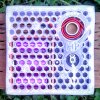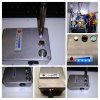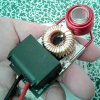TheThriftDrifter
Land of the long vapor cloud
Beautifully done. Any chance of a vid?
@TommyDee . That is small. Looks Jetsons futuristic. I never would have thought to use a wood cylinder as a spacer. Two very exciting heaters guys!
Beautifully done. Any chance of a vid?
@TommyDee . That is small. Looks Jetsons futuristic. I never would have thought to use a wood cylinder as a spacer. Two very exciting heaters guys!



I'll take 2 they ready yet?Today I recycled 2 coke bottles for a good purpose. Of course, I also wasted several ounces of ABS plastic getting to this point. I actually got a decent 2-tone cover but it warped. Nice touch but not for this design. My PLA selection sucks, and another ABS just plain failed. So, PETG to the rescue. PETG is also known as Coke bottles. Naturally translucent it makes for a tough yet somewhat flexible structures. This is a simple top and bottom shell. Both have the open honeycomb pattern.
The "HP" stands for HalfPint. The entire unit has 2 16 gauge silicon rubber power leads hardwired between the ZVS board and the battery case. The batteries are removable for charging. The battery case is free to be removed from the case while the ZVS board is tacked down at the capacitor on the floor, and along 2 adjacent edges along the wall. This 'fixing' with hot glue also stabilized the relatively thin constitution of the box.
View attachment 1288 View attachment 1289
And HalfPint it's a cordless coffee table unit that can go outside for a quick puff. With the hexagon texture and the 'softness' of the thin PETG makes this IH 'easy' to handle. Enough heft to hold fast on a surface but definitely light enough to use as a torch. A single button to push, a blue LED on-board to indicate heating, and an adjustable-depth cup for heating preferences. All within a 4"x4"x1" brick weighing in at under 7-oz.
Good point. I talked to someone into electric stuff... he raised the eyebrows and told me whatever frequencies leave the unit could be harmful. So, no pacemakers please! I will pass him over a standard and a half-pint to do some testings. I will report.We should gather a consortium of makers and do artisan commissions. People make modules, others make cases, and another consolidates.
This would be highly inappropriate as a product considering it doesn't even have a proper fuse. This is minimalist to the max!
The only thing managed with this is thermal. Nothings gets stupid-hot with normal use. And nothing except a fault condition will leave the unit running.
If anything ever goes stupid, I have a big yard to toss the flaming embers onto. Overnight, the batteries are charging and out of the unit.






As the (3) 18650’s voltage slowly drops, the 1st DV click timings will slowly grow as well. If you get 1st click at 4-5 seconds while batteries are freshly charged at about 12 volts, after much use, and total voltage drops to 10.6 volts, the 1st click will take longer, 7-?, (I’m still testing), but longer 1st click times are another clue, besides battery voltage, that it’s time to charge batteries. BTW: Fluxer’s with battery life switch/LED, the green-green/red- red LED’s, are surprisingly accurate indicators of remaining battery life.
Nice write up TommyDee.
Having only my SKJ IH previous to my FD, I’m curious what if anything is used on IH units like the Apollo, to keep the hot DV tip, from the push down switch? As you know the FD has a tiny glass button glued to the top of the switch, so it can’t melt. Do the commercial IH devices use the same or similar switches, and are they left stick/bare?
Thanks.
Sorry, thought you had an Apollo at one point. I’ll see if I can find a photo online, or perhaps someone that has one can reply?
As far as using the cap to make the circuit, it was either in this thread or the old one, if you recall someone tried something similar, but the metal acted as a heat sink, so NG. Seems if the switch is going to at the bottom of the coil, it needs some type of non metal insulator. I know Mr. C, looked long and hard on this subject, thus I was interested in how other builders, especially the commercial ones, have approached this issue.
@RustyOldNail It look like it's a silicone cap at the bottom of my apollo. It's the same thing on both models.View attachment 1518View attachment 1519
Thank you for taking your time to take photos & post! That’s very interesting, wonder what temperature that silicone is rated for? The switch on the FD is high temp rated, but from my limited understanding, most of the custom coil choices Mr. C offers can run hotter, then the types used in many of the commercial ones, and thus if a DV sits too long on a bare plastic/composite switch, can melt it, (photos in this or OGFC thread). The glass button solution he employs works great. I was just curious. Thanks.



Sorry but I seen on the first page one you made called the halfpint it has only one yellow inductor. And one cap that's the one I was asking about.Hey @Edgedamage - I am running the board on two inductors with a shared core. I count windings directly to the middle and scrape the insulation so I can add positive potential right there. Effectively, I cut the coil in half. It should cut the down from 100uh to 50uh. Within an IH circuit, this changes the frequency. I also removed one of the caps. That is what makes it a "HalfPint". I noticed the Apollo 2 only has one cap and that is what gave me the idea to cut the circuit in half.
Cutting the trace is board dependent. I have 3 versions and they all treat that trace differently. Follow the circuit. On some, the 3-pin output connector, center pin, is connected to the middle termination between the inductors. Some are not. I make sure the power lead from the positive input connector, the 2-pin connector, that the trace fully powers the 470 ohm resistors. There may be vias along that trace that need to be removed from positive input voltage. The remaining trace can be cut to disconnect the positive input voltage. By doing this, isolating the gate circuit, you can use a switch that will drive only the LED, mere milliamps, and 'signal' the gate circuit. Signal means it only requires voltage to the gate, it does not draw current. So the switch has very little power going through it. It is the very same as the switch you use for the MOSFET switch which becomes redundant with the circuit I am describing.
Joanne's and Covid just don't work well together. Amazing how patient their customers are. Drives me postal!
Hmmm ... as a host of a Pacemaker (actually, a fancy double-duty one that also has a built-in defibrillator = ICD) this caught my attention. I never considered it. I don't want to discuss this with my cardiologist, but I'd like to know more about it. With whom should I discuss it, I wonder? Perhaps the ICD manufacturer (Medtronic) would be the best source. Dang ... why did I have to see this??????Good point. I talked to someone into electric stuff... he raised the eyebrows and told me whatever frequencies leave the unit could be harmful. So, no pacemakers please!
 But, thanks for making me think about it. Maybe I'll have to get on that's specially shielded somehow!
But, thanks for making me think about it. Maybe I'll have to get on that's specially shielded somehow!Yes, that is what I am describing.Sorry but I seen on the first page one you made called the halfpint it has only one yellow inductor. And one cap that's the one I was asking about.



